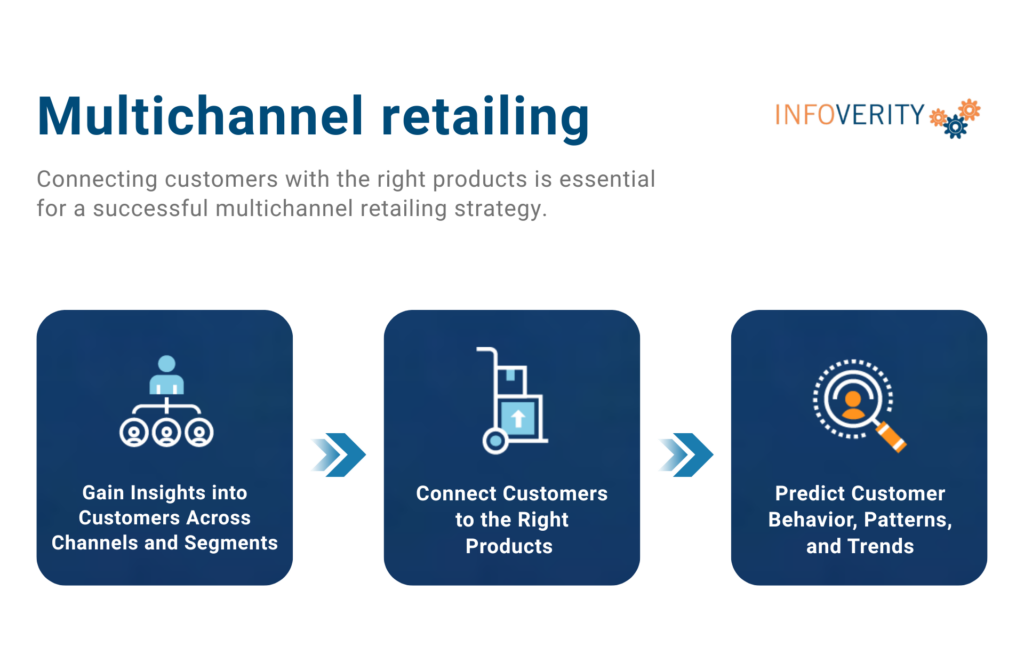In today’s fast-paced and digitally driven retail environment, mastering multichannel retailing is crucial for businesses looking to thrive. Embracing a multichannel approach allows retailers to meet customers where they are. Thus, they can offer seamless shopping experiences across various online and offline platforms. To excel in this competitive landscape, businesses must understand the intricacies of multichannel retailing. As a result, they must implement strategies that prioritize integration, consistency, and customer satisfaction.
Multichannel Retailing: Table of Contents
What is Multichannel Retailing?
Multichannel retailing is a strategy that involves selling products or services through multiple independent channels. Some examples are brick-and-mortar stores, online marketplaces, social media platforms, mobile apps, and more. By seamlessly integrating online and offline channels, retailers can provide a unified shopping experience. Meeting the evolving needs and preferences of today’s consumers.
The Evolution of Multichannel Retailing
The evolution of retail has been nothing short of remarkable, reflecting shifts in technology, consumer behavior, and market dynamics.
From the bustling marketplaces of ancient times to the rise of department stores in the late 19th century, retailers have been continually adapting to meet the needs of their customers. Afterwards, the latter part of the 20th century saw the emergence of big-box retailers. This changed the shopping experience yet again, offering convenience and low prices.
We’ve witnessed a major transformation with the advent of e-commerce, allowing consumers to shop from anywhere at any time. Even so, businesses are expanding their strategies beyond traditional e-commerce to stay ahead of the curve.
The COVID-19 pandemic fueled a remarkable surge in digital retail and online shopping across the globe. The rise in online interactions accelerated customer expectations requiring retailers to change how they interact and engage with their shoppers. Enter social media platforms, which revolutionized this interaction.
Brands are redefining the customer’s journey from mere browsing to relationship-building and authentic interaction before a purchase is even made. McKinsey recorded that in 2021, $37 billion in goods and services were purchased through social commerce channels. By 2025, the social-commerce market is expected to grow to more than $2 trillion globally.
The Future of Retail: Innovation, Customization and Sustainability
ULTA Beauty partnered with Snapchat to create catalog-powered Augmented Reality (AR) lenses to drive product engagement and sales. The initial roll-out generated $6 million in sales and more than 30 million product-try ons during a two-week period. Most importantly, it led to an additional 43% incremental reach relative to the audience ULTA Beauty was previously reaching.
The future of retail is set to be an exciting blend of technology and personalization, reshaping the way consumers engage with brands. Also, as advancements like AR and AI become more integrated, shopping will evolve into a highly immersive experience. This also allows customers to try products virtually or receive personalized recommendations at their fingertips.
Sustainability will also play a crucial role, with consumers increasingly seeking brands that prioritize eco-friendly practices. Additionally, the retail landscape is moving toward a more dynamic and customer-driven model. In this context, flexibility and innovation are essential for success.
Given these points, let’s delve deeper into how businesses can succeed in multichannel retailing with a customer-centric approach.
Looking for guidance in your multichannel retail strategy?
Infoverity can help you to optimize data accuracy and empower your organization with our expert data management consultancy services 
Create Meaningful, Relevant, and Cohesive Experiences
Imagine as a customer, checking out online, only to find that the inventory in store doesn’t match what you saw online – frustrating, right? When customers interact with a brand – whether it’s online, through social media, or in a store – they expect a seamless experience backed by accurate information. Likewise, implementing consistent branding and seamless integration across channels ensures that customers enjoy a unified experience. No matter how they engage with the brand.
To achieve this, businesses should invest in technologies to facilitate communication and the synchronization of data across channels in real-time. This minimizes discrepancies in inventory, pricing, and customer details. The payoff is significant: when customers receive consistent and relevant messaging, it builds trust and drives loyalty. Moreover, having a unified view of operations makes it easier to adapt to market trends and customer preferences, giving businesses an edge in a competitive environment.

Gain Insights into Customers Across Channels and Segments
Deeply understanding your customer segments and their preferred shopping channels is crucial for businesses looking to drive an effective omnichannel strategy. Additionally, according to a recent study, 71% of consumers expect companies to deliver personalized interactions and 76% get frustrated when this doesn’t happen. Putting customers at the heart of an omnichannel strategy enables businesses to create a more personable shopping experience.
By analyzing insights from different customer groups, businesses can identify unique preferences and behaviors, tailoring marketing efforts to resonate with each segment. For instance, younger customers might engage more through social media and mobile apps, while older shoppers may prefer traditional email or in-store experiences. By visualizing these insights, businesses can create target campaigns that deliver the right message to the right audience at the right time. This not only enhances customer satisfaction but also fosters loyalty, turning occasional shoppers into lifelong brand advocates. In a landscape where personalization is key, leveraging customer insights alongside channel preferences can significantly boost engagement and drive growth.
Statistics
A McKinsey survey revealed that more than 67% of businesses indicated that their biggest challenge to personalization is the gathering, integration, and synthesis of customer data. Start by collecting and analyzing customer data to understand their preferences and shopping behaviors, allowing you to tailor your marketing and product offerings accordingly.
Connect Customers to the Right Products with a Multichannel Retailing Strategy
Connecting customers with the right products is essential for a successful multichannel retailing strategy. Businesses can achieve this by utilizing data analytics and customer feedback to understand buying habits and preferences. Categorizing products, not just by type, but also by customer segments, enables businesses to recommend items that align with individual lifestyles. Implementing techniques such as recommendation engines on digital channels, curating in-store displays based on local preferences, or even sending tailored e-mails can help guide customers seamlessly from one channel to another.
When customers feel understood and catered to, it enhances their shopping journey and drives both engagement and sales across every platform. Eventually, it’s about creating a unique and meaningful experience that leads customers straight to products they’re excited about, no matter where they choose to shop.
Predict Customer Behavior, Patterns, and Trends
Predicting future customer behaviors is a game changer for developing an effective multichannel strategy. Furthermore, businesses can foresee what customers are likely to want in the future by analyzing historical data and trends. This foresight allows them to align their marketing efforts, inventory, and customer engagement across various platforms. Also ensuring they reach customers where they are most active. For instance, if data suggests an uptick in online shopping during certain seasons, businesses can ramp up their online promotions and stock levels accordingly. This proactive approach helps businesses uncover insights that drive smarter decision-making.
To effectively harness data analytics, businesses should be looking into solutions that aggregate data from all touchpoints, allowing insights into trends and performance metrics in real time. Not only can businesses identify which channels are thriving and which need tweaking, but they can personalize marketing efforts, improve inventory management, and enhance customer experiences. In a landscape where customer expectations are higher than ever, data-driven decision-making is essential for sustained growth and success.
Elevate Your Multichannel Retail Strategy with a Customer-Centric Approach
Successful multichannel retailing hinges on a few key principles that prioritize the customer experience. By leading with a customer-centric approach, businesses can better understand and cater to the needs and preferences of their shoppers. Multichannel is not just a trend but a necessity. It allows businesses looking to stay competitive, drive growth, and build lasting relationships with their customers.
Enhance your multichannel retail strategy with our expert data management consultancy services, designed to optimize data accuracy and empower your organization to boost customer loyalty, increase sales, and elevate satisfaction across every channel.
Get in touch with Infoverity today to start your data-driven journey. Meet customers where they want to be met, anytime and anywhere.
FAQ – Multichannel retailing
What is multichannel retailing?
Mastering multichannel retailing is crucial for businesses looking to thrive. Embracing a multichannel approach allows retailers to meet customers where they are. To excel in this competitive landscape, businesses must understand the intricacies of multichannel retailing.
How does multichannel retailing improve the customer experience?
Successful multichannel retailing hinges on a few key principles that prioritize the customer experience. By leading with a customer-centric approach, businesses can better understand and cater to the needs and preferences of their shoppers.
What is an example of a multichannel distribution?
Some examples are brick-and-mortar stores, online marketplaces, social media platforms, mobile apps, and more. By seamlessly integrating online and offline channels, retailers can provide a unified shopping experience. Meeting the evolving needs and preferences of today’s consumers.
What are the advantages of multichannel retailing?
Multichannel is not just a trend but a necessity. It allows businesses looking to stay competitive, drive growth, and build lasting relationships with their customers.



